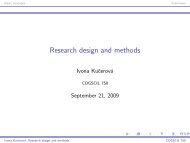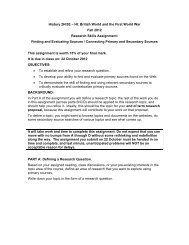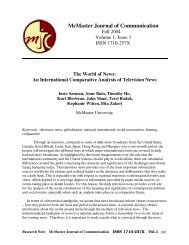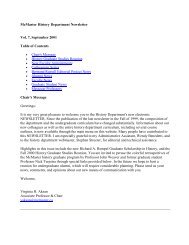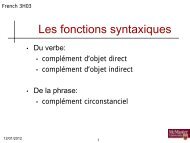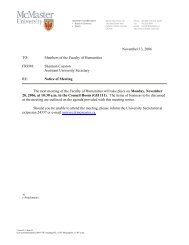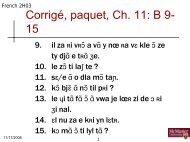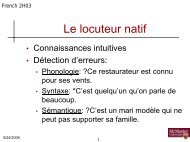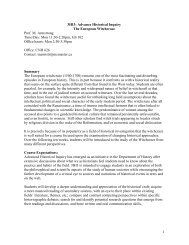The Syntax of Givenness Ivona Kucerová
The Syntax of Givenness Ivona Kucerová
The Syntax of Givenness Ivona Kucerová
Create successful ePaper yourself
Turn your PDF publications into a flip-book with our unique Google optimized e-Paper software.
(70) st<br />
terminating point<br />
object<br />
e,st<br />
λ<br />
st<br />
subject<br />
G . . .<br />
Thus if there is only one G-operator per propositional domain (which seems to be correct<br />
considering the nature <strong>of</strong> the G-operator, though this is hard to test), unless the object<br />
moves before the subject is merged the object could not be interpreted as presupposed. I<br />
therefore conclude that we need an independent requirement which prefers derivations with<br />
very local movement to derivations with a non-local G-movement.<br />
Another issue that has remained unanswered so far is when exactly the Maximize presupposition<br />
evaluation takes place. I assume that the evaluation may happen at the end <strong>of</strong><br />
a phase. This allows limitation <strong>of</strong> the global comparison only to structures which can be<br />
derived within a phase from the same numeration. I assume this is possible under the assumption<br />
that phases correspond to propositions. But nothing in our system depends on this<br />
choice. If it turns out that presuppositions are computed only at the level <strong>of</strong> the utterance,<br />
the system can be straightforwardly adjusted to that.<br />
4.3 <strong>The</strong> evaluation component<br />
In the previous section we have concentrated on defining a given operator and on introducing<br />
such an operator within the logical form. In this section, I will set up a formal<br />
evaluation component for the purposes <strong>of</strong> Maximize presupposition. This step will complete<br />
the modification <strong>of</strong> the originally purely syntactic system. In the rest <strong>of</strong> this section I<br />
will examine whether the modified system can account for the data from chapters 2 and 3<br />
that we originally covered by G-movement.<br />
To see exactly how the evaluation component works we need not only to define the reference<br />
set but also to have a clear metrics that we can use to compare different derivations.<br />
We already have a definition <strong>of</strong> a reference set. <strong>The</strong> definition is repeated below.<br />
(71) Reference set for Maximize Presupposition evaluation<br />
For purposes <strong>of</strong> Maximize Presupposition, the reference set, toward which Maximize<br />
presupposition is evaluated, consists <strong>of</strong> all derivations<br />
a. that are based on the same numeration and free insertion <strong>of</strong> a G-operator, and<br />
b. that make the same assertion.<br />
In order to have a clear metrics I will define two constraints with respect to which each<br />
candidate within a reference set will be evaluated. 16 First, we need to guarantee that all<br />
16 <strong>The</strong> reader should not be misled by the terminology. <strong>The</strong> system developed here is not an optimality<br />
109





